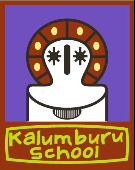
|
Kalumburu Remote Community School (5236)
|
School Overview
|
Growing strong, smart, safe & caring learners at the top of the state!
Kalumburu - meaning 'Path By The River' or 'River Crossing' - is the most northerly Aboriginal Community in Western Australia. It is situated on the banks of the King Edward River beside a long, deep billabong at the upriver end of Malindjar Gorge. The nearest townships to Kalumburu are Kununurra (565km SE), Wyndham (560km SE) and Derby (650km W). Road access to the region is via the unsealed Gibb River Road and dependent on seasonal conditions. Kalumburu is often inaccessible by road for four to six months of the year. Alternative access is by air and supplies are regularly delivered by sea.
Climate
Traditionally, the Kwini and Wunambal Gaambera calendars identify 5-6 seasons. The climate can be broadly described as having a mid-year dry season and a summer wet season. Rainfall during 'The Wet' can be extreme and tropical lows and cyclones do pass through the area. Wet season temperatures are typically high 30's and humidity is often in the high 80-90% level. Dry season daytime temperatures range from high 20's to low 30's, and night time temperatures can drop to 10 degrees. The Kalumburu Road is closed throughout the wet season each year, with the duration of closure dependent on rainfall and damage caused to the road. River height, mud, washaways and general road erosion can effect access typically from November until early to mid-May of the following year. The community is serviced by an all-weather airstrip with night landing facilities.
People
Continuous habitation of the area appears certain for more than 5,000 years with some research suggesting that habitation could have occurred as long ago as 70,000 years. The Country belongs to the Kwini people; other prominent tribal groupings of the region are Gulari, Wanambal, Gaambera and Worrora peoples. Family relationships spread from Broome through to Kununurra and also extend into the Pilbara and Northern Territory. Many families are transient between towns throughout the year.
The community of Kalumburu currently numbers around 450 people and is serviced by the school, community clinic, local police station, grocery store, fuel station and an administration office providing postal, banking and Centrelink services.
Mission
Missions of several religious orders were set up across the Kimberley during the early 1900's at a number of sites. Formerly the 'Drysdale River Mission', Kalumburu Mission was founded in 1908 by Benedictine missionaries from New Norcia. The original settlement was at Pago, some 30 kilometres to the North East of present day Kalumburu. Shortage of water to serve the growing numbers of mission staff and aboriginal residents prompted a move to the present site in the period of 1932 to 1938. The Kalumburu Mission still plays an active role in the day-to-day activities of the residents of Kalumburu, running church services and diesel/unleaded fuel sales.
School Priorities
The School Strategic Plan 2023-2025 lists the priority areas for the school as:
- Attendance
- Secondary pathways
- Evidence-based teaching
- Trauma-informed, culturally responsive practice
- Cultural connections and community partnerships
We implement Positive Behaviour Supports school-wide and have the four behaviour expectations of being Strong, Smart, Safe and Caring.
From 2019, the school has been part of the Kimberley Schools Project, a federally-funded initiative established to strengthen teaching pedagogy and improve outcomes for Kimberley students. The four pillars of the project are targeted teaching, better early years learning and care, regular attendance, and increased student and community engagement. Kalumburu School receives support in the form of professional learning, coaching and funding through its participation in the project.
The school currently runs a 0-3 KindiLink program, two Early Years classes, three composite Primary classes and two composite Secondary classes. Specialist teachers run Health and Physical Education, Cooking and Art classes across the school. A local language (Wunambal) is taught through a weekly class.
Annual events on our calendar include Kimberley Cup (years 7-12 students), Bike Camp (years 4-12 students) and Culture Camp (years 4-6 students) as well as Kalumburu Day, Athletics and Swimming carnivals and NAIDOC and Stronger Smarter days celebrating Culture and togetherness. Community participation and involvement in the school is actively encouraged. Parents of award recipients are personally invited to our weekly assembly, and attendance at carnivals and other events is promoted.
|
|
|
|